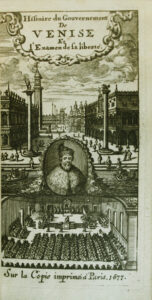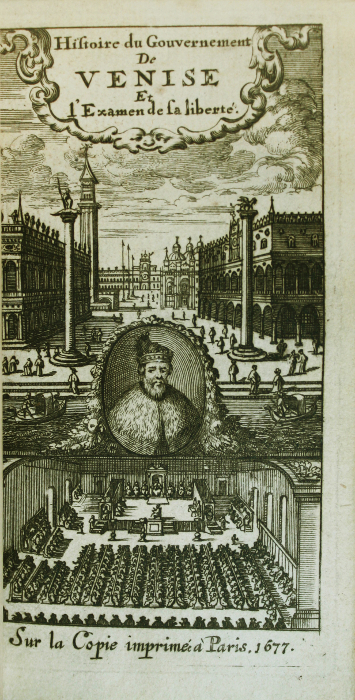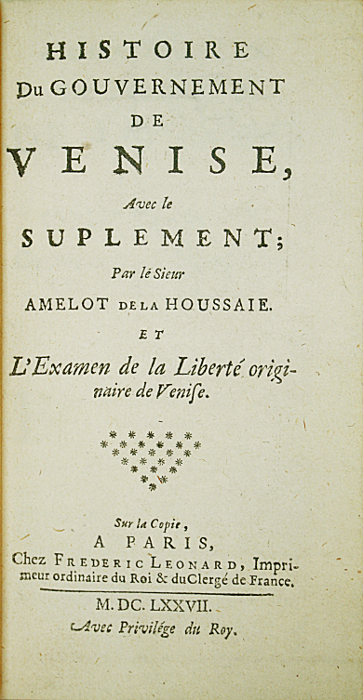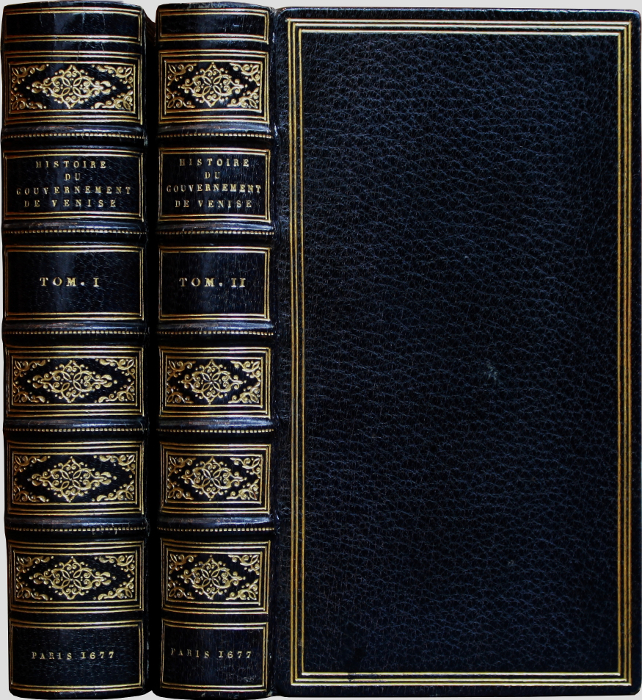Sur la Copie, A Paris, chez Frederic Leonard, 1677.
Bound with : Examen de la liberté originaire de Venise. Traduit de l’Italien. Avec une Harangue de Louis Hélian Ambassadeur de France contre les Vénitiens, Traduite du Latin. Et des Remarques Historiques. Sur la Copie à Ratisbonne, chez Jean Aubri, 1677.
2 volumes 12mo [134 x 74 mm] of : I/ (2) bl. ll., (12) ll. including 1 engraved frontispiece, 550 pp., (19) ll. for the table, (2) bl. ll.; II/ (2) bl. ll., 237 pp., (3) pp. of table, (6) ll., 211 pp., (3) pp., (2) bl. ll. Bound in blue full morocco, triple gilt fillets on covers, spines ribbed and richly gilt, inner gilt borders, gilt edges. Binding signed Bauzonnet-Trautz.
Second edition enlarged with this story of the Government of Venice that brought its author to be imprisoned into the Bastille. Willems 1907; Ruble, Catalogue des livres rares, 671 ; Brunet, V, 502.
The author was the secretary of the French embassy in Venice. Through this account comprising important revelations regarding the Venetian government’s politics, Amelot de la Houssaye undertook to criticize the administration of this republic and to expound the causes of its decadence. The work was first published in March 1676 and as it did not seem to be disapproved of by the royal power, caused indignant protests from the Venetian ambassador Giustiniani. The author was sent to the Bastille where he stayed only six months. A second edition, with supplements, published immediately after, renewed these protests, and the edition was forbidden. This persecution was an extraordinary publicity for this work which had twenty-two editions in three years, and several translations.
« Amelot de la Houssaye, a famous French adman, born in Orleans in February 1634, dead in Paris on December 8th, 1706. He was first secretary of embassy in Venice, and dedicated himself to the study of history, moral and philosophy: here is everything we know about his life. He is criticized for the hardness of his style; but his exactness towards facts and the appropriateness of his mind excuse this fault. Amelot’s main works are: ‘Histoire du gouvernement de Venise’, Amsterdam, 1676, 1705, 3 vol. 12mo, with a supplement. This work, which, for the first time, brought to light the maxims of the Republic of Venice, became the object of complaints from the Venetian Senate towards the Court of France. Bayle says the author was imprisoned into the Bastille. » (Nouvelle Biographie générale, II, 351).
The present copy is quoted by Willems: « Vendu mar. bl. (Bauzonnet) 100 frs. Yemeniz ».
« This work, full of satirical touches, however very appropriate to make the government of Venice known, displeased the Senate, which complained to the Court of France; it is even said that the author was imprisoned into the Bastille. » (Michaud, Biographie universelle, 36)
« This work caused a scandal when published, and the Senate of Venice, by qualifying it of seditious, condemned it to fire… We have a French translation of it under the title of ‘Examen de la liberté originaire de Venise’, by Amelot de la Houssaye , who combined it with the translation of a Latin harangue by Louis Helian, against the Venetians, pronounced in 1510, the whole printed under the date of Ratisbon, 1677, 12mo. » (Brunet)
A precious copy of this political work condemned to fire since its publication, finely bound in blue morocco by Trautz-Bauzonnet, quoted by Willems.
Provenance : Duc de Chartres and Yemeniz collections (ex libris).
See less information




